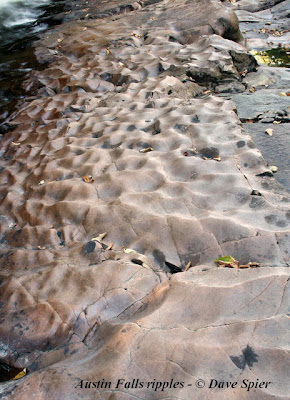Austin Falls is on the Sacandaga River between Speculator and Wells in Hamilton County. Use Old State Rt. 8/30, which has vehicle access only at it's north end. The old bridge at the south end has been closed for a long time.
Directions from the north: (distances may vary due to differences in odometer calibration) From the Speculator Community Park (and River Walk Trail) next to the Sacandaga River outlet from Lake Pleasant (south of Speculator's four-corners), drive south on Rts. 8/30. To give you an idea of my odometer calibration, at 1.35 miles, pass the south end of Downey Ave. At 2.8 miles, look for the "Town of Wells" sign and turn left onto Old State Rt. 8/30 and within 1/10th mile, cross a one-lane bridge over the Sacandaga River. Reset your trip odometer to 0. (Portions of Old Rt. 8/30 are rough and bumpy, especially where the old pavement has buckled.) At 1.1 mile from the bridge, pass by Fly Creek Rd. (dirt) which goes left. At 1.9 miles, pass Robbs Creek. At 2.1 miles, cross a narrow, one-lane bridge over a tributary stream. Again, reset to 0.0 and at 0.4 mile beyond this second bridge, watch for a flat-water stretch of the Sacandaga on your right (west); this is just above the Austin Falls narrows. At 0.7 mile beyond the 2nd bridge, look for an inconspicuous pull-off on the right. If you get out of your vehicle, you should be looking down a short hill to the river at the base of the falls, which is actually more of a long sluice or channel with a short drop at the end. Total driving distance from NY 8/30 was 2.8 miles on my truck's odometer, but the ADK Guide to Adirondack Trails 3 lists it as 2.6 miles. The Adirondack Waterfall Guide says 2.7 miles. Take your pick.
 |
| blocks of granite gneiss created by sets of parallel joints (vertical cracks) |
Directions from the south: according to the ADK Guide to Adirondack Trails 3, it is 6.5 miles from the junction of Rts. 8 and 30 (north of Wells) to Old Rt. 8/30, which is a right turn from the south. Proceed as above.
After parking, a short walk downhill leads to the river and lower falls where layers of (what is likely) granite gneiss are broken into blocks by intersecting joints (vertical cracks). From the base of the falls, look upstream (northward) and it's obvious the metamorphic rock layers dip to the west. Climb around these on the right and walk on the sloping rock surface to head upstream on the right side of the rushing river channel which is working its way down a resistant layer and cutting into overlying strata. Interesting geological features include potholes "drilled" into the gneiss, glacial striations (according to one guidebook), and further upstream, a very rippled rock surface (which is what I suspect the book referred to as "ocean-bottom evidence"), although I suspect the river could be entirely responsible (see the last photo).
 |
| Donna's photos taken 8/25/12; this image at 1:45 pm (when the river channel was in deep shade) |
Photography notes: On sunny days, there is a narrow window of opportunity in the middle of the day when the sunlight reaches the water. By early afternoon, the water is in deep shade while the sun still hits the sloping rock shelf and trees on the east side. This makes the lighting very harsh and nearly impossible to balance without special software. Later in the afternoon, the entire scene is back in shade and light is more balanced for landscapes. Clouds also will even the light. If you shoot RAW, it's easier to adjust the white balance or use the white-point tool on whitewater (although I prefer to push the balance toward the warmer tones). If you have High Dynamic Range (HDR) software, you can shoot several different exposures and combine them, or create several pseudo-exposures from one RAW capture.
 |
| 17mm wideangle on full-frame body, exp. 0.7" at f/22, ISO 100, shade white balance; most photos from 9/22/07 |
My basic landscape camera is a full-frame digital body with a 17-40mm zoom, all mounted on a tripod. This permits high depth of field (small aperature) which necessitates slower shutter speeds to compensate. If you don't have a remote-release cable or trigger, you can use the self-timer.
References
Adirondack Waterfall Guide, by Russell Dunn (© 2004), published by Black Dome Press
Guide to Adirondack Trails: 3 - Central Region, by Bruce Wadsworth (© 1994, reprinted with revisions 2000), published by the Adirondack Mountain Club
New York State Atlas & Gazetteer, published by DeLorme Mapping Co.
Roadside Geology of New York, by Bradford VanDiver, PhD (© 1985/reprinted 2003), published by Mountain Press
Corrections, comments and questions are always welcome at northeastnaturalist@yahoo.com or connect through my Facebook page and photo page. There is a separate Fb page for The Northeast Naturalist. Other nature and geology topics can be found on the parallel blogs Northeast Naturalist and Heading Out.






